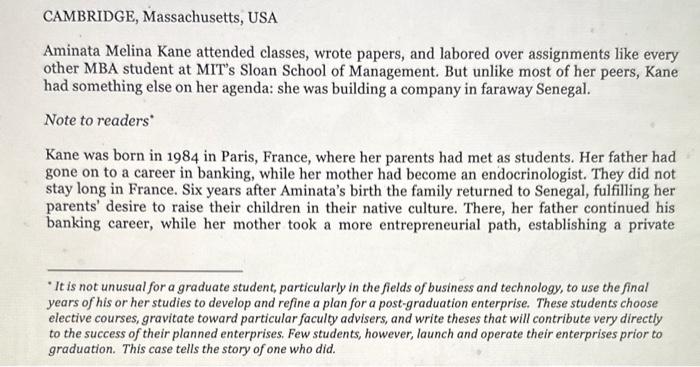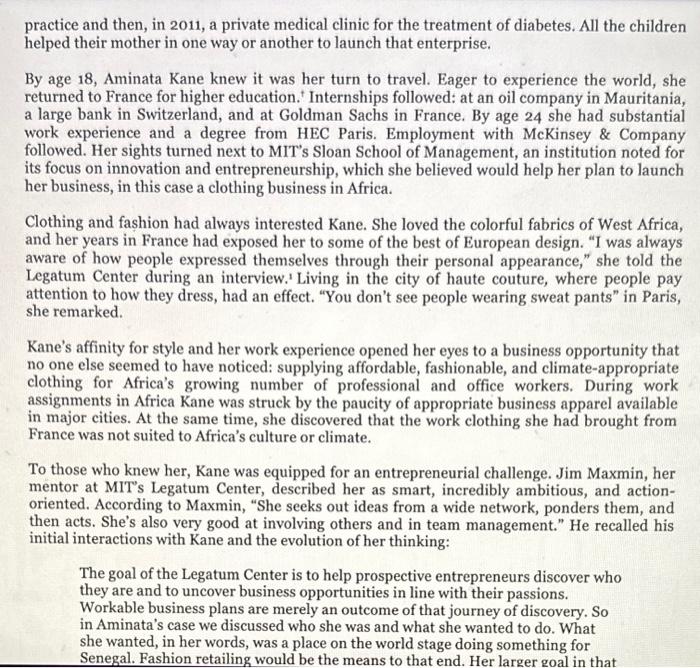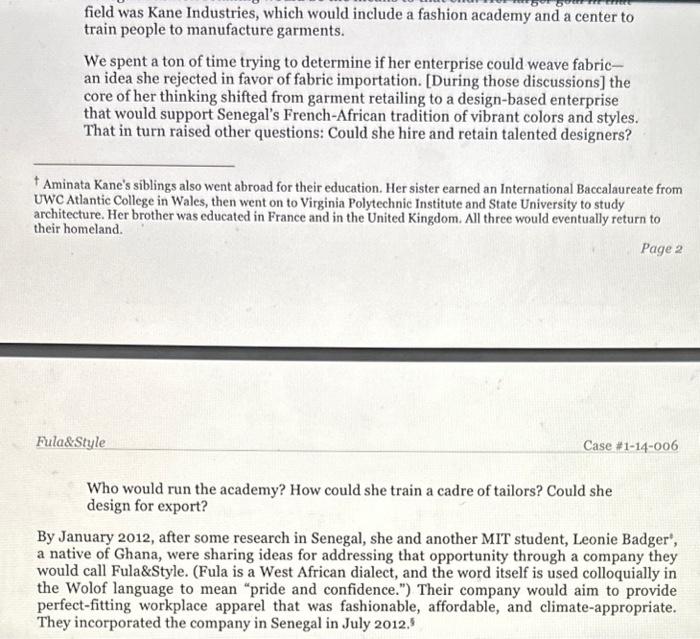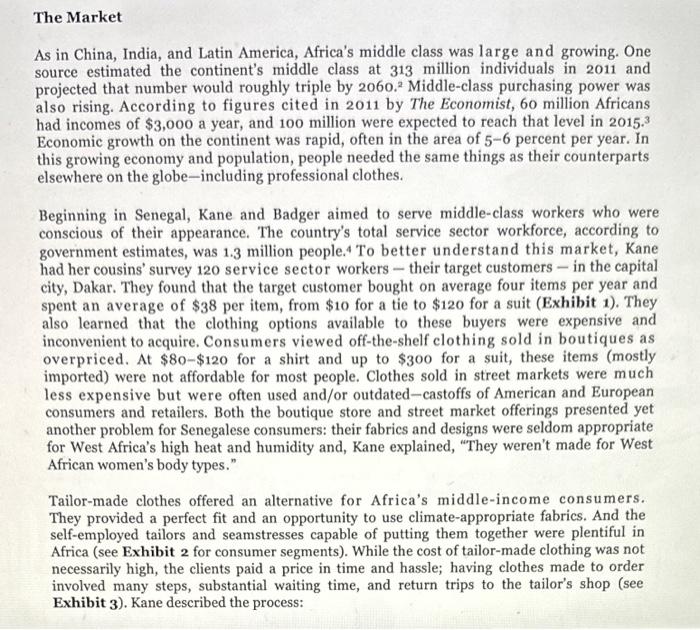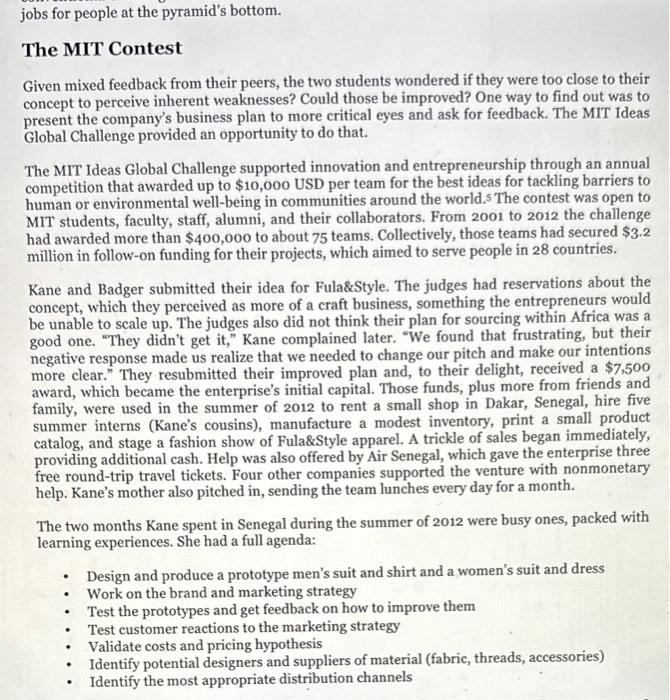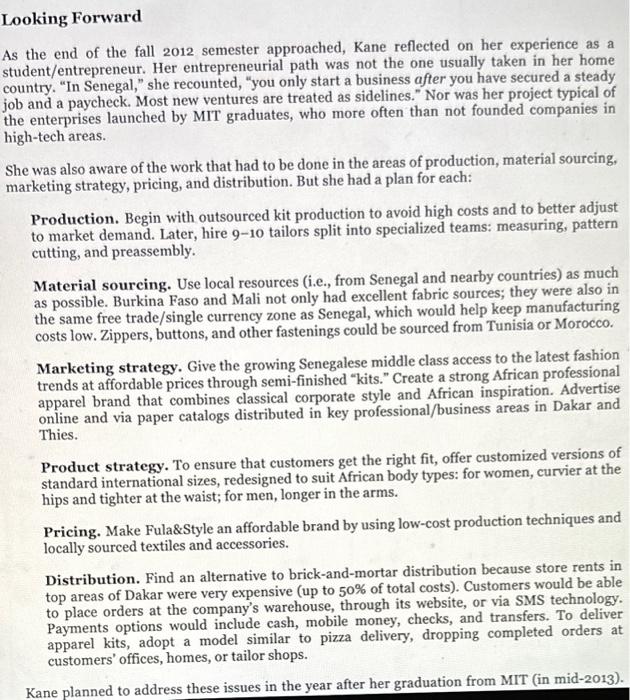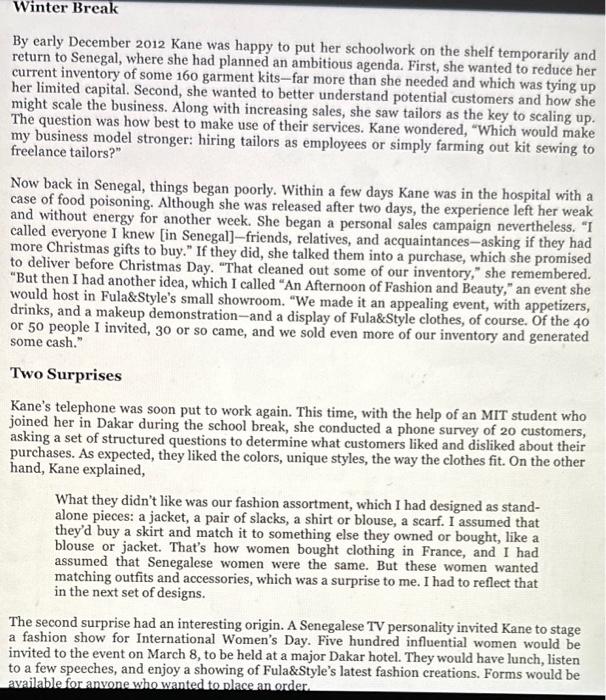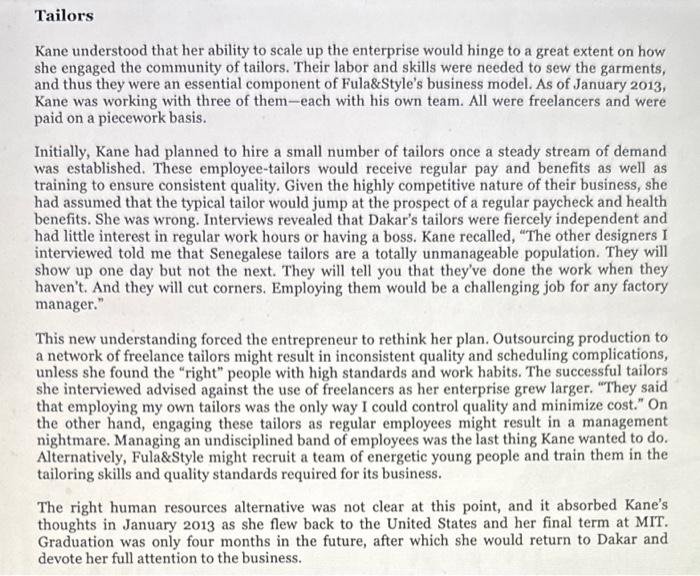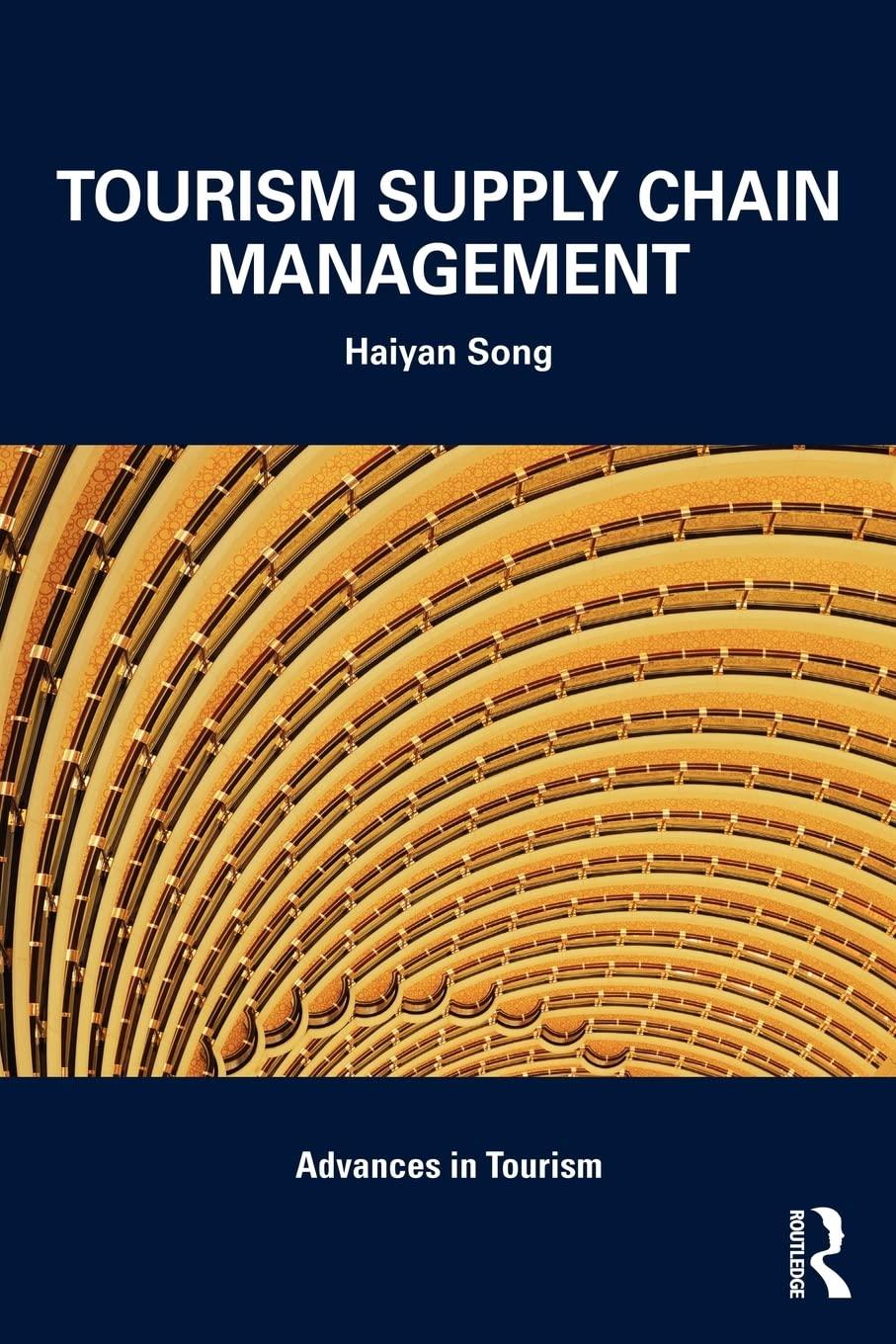PLEASE HELP!!
QUESTION:

ARTICLE:
4. Kane faced a difficult choice: outsource production to an undisciplined population of independent tailors or hire and train her own people. Discuss the merits and demerits of each option (1) at this early stage in the company's evolution and (2) as it grows larger. CAMBRIDGE, Massachusetts, USA Aminata Melina Kane attended classes, wrote papers, and labored over assignments like every other MBA student at MIT's Sloan School of Management. But unlike most of her peers, Kane had something else on her agenda: she was building a company in faraway Senegal. Note to readers Kane was born in 1984 in Paris, France, where her parents had met as students. Her father had gone on to a career in banking, while her mother had become an endocrinologist. They did not stay long in France. Six years after Aminata's birth the family returned to Senegal, fulfilling her parents' desire to raise their children in their native culture. There, her father continued his banking career, while her mother took a more entrepreneurial path, establishing a private "It is not unusual for a graduate student, particularly in the fields of business and technology, to use the final years of his or her studies to develop and refine a plan for a post-graduation enterprise. These students choose elective courses, gravitate toward particular faculty advisers, and write theses that will contribute very directly to the success of their planned enterprises. Few students, however, launch and operate their enterprises prior to graduation. This case tells the story of one who did. practice and then, in 2011, a private medical clinic for the treatment of diabetes. All the children helped their mother in one way or another to launch that enterprise. By age 18, Aminata Kane knew it was her turn to travel. Eager to experience the world, she returned to France for higher education. Internships followed: at an oil company in Mauritania, a large bank in Switzerland, and at Goldman Sachs in France. By age 24 she had substantial work experience and a degree from HEC Paris. Employment with McKinsey \& Company followed. Her sights turned next to MIT's Sloan School of Management, an institution noted for its focus on innovation and entrepreneurship, which she believed would help her plan to launch her business, in this case a clothing business in Africa. Clothing and fashion had always interested Kane. She loved the colorful fabrics of West Africa, and her years in France had exposed her to some of the best of European design. "I was always aware of how people expressed themselves through their personal appearance," she told the Legatum Center during an interview.' Living in the city of haute couture, where people pay attention to how they dress, had an effect. "You don't see people wearing sweat pants" in Paris, she remarked. Kane's affinity for style and her work experience opened her eyes to a business opportunity that no one else seemed to have noticed: supplying affordable, fashionable, and climate-appropriate clothing for Africa's growing number of professional and office workers. During work assignments in Africa Kane was struck by the paucity of appropriate business apparel available in major cities. At the same time, she discovered that the work clothing she had brought from France was not suited to Africa's culture or climate. To those who knew her, Kane was equipped for an entrepreneurial challenge. Jim Maxmin, her mentor at MIT's Legatum Center, described her as smart, incredibly ambitious, and actionoriented. According to Maxmin, "She seeks out ideas from a wide network, ponders them, and then acts. She's also very good at involving others and in team management." He recalled his initial interactions with Kane and the evolution of her thinking: The goal of the Legatum Center is to help prospective entrepreneurs discover who they are and to uncover business opportunities in line with their passions. Workable business plans are merely an outcome of that journey of discovery. So in Aminata's case we discussed who she was and what she wanted to do. What she wanted, in her words, was a place on the world stage doing something for Senegal. Fashion retailing would be the means to that end. Her larger goal in that field was Kane Industries, which would include a fashion academy and a center to train people to manufacture garments. We spent a ton of time trying to determine if her enterprise could weave fabrican idea she rejected in favor of fabric importation. [During those discussions] the core of her thinking shifted from garment retailing to a design-based enterprise that would support Senegal's French-African tradition of vibrant colors and styles. That in turn raised other questions: Could she hire and retain talented designers? Aminata Kane's siblings also went abroad for their education. Her sister earned an International Baccalaureate from UWC Atlantic College in Wales, then went on to Virginia Polytechnic Institute and State University to study architecture. Her brother was educated in France and in the United Kingdom. All three would eventually return to their homeland. Fula\&Style Case #114006 Who would run the academy? How could she train a cadre of tailors? Could she design for export? By January 2012, after some research in Senegal, she and another MIT student, Leonie Badger', a native of Ghana, were sharing ideas for addressing that opportunity through a company they would call Fula\&Style. (Fula is a West African dialect, and the word itself is used colloquially in the Wolof language to mean "pride and confidence.") Their company would aim to provide perfect-fitting workplace apparel that was fashionable, affordable, and climate-appropriate. They incorporated the company in Senegal in July 2012.,9 As in China, India, and Latin America, Africa's middle class was large and growing. One source estimated the continent's middle class at 313million individuals in 2011 and projected that number would roughly triple by 20602 Middle-class purchasing power was also rising. According to figures cited in 2011 by The Economist, 60 million Africans had incomes of $3,000 a year, and 100 million were expected to reach that level in 20153 Economic growth on the continent was rapid, often in the area of 56 percent per year. In this growing economy and population, people needed the same things as their counterparts elsewhere on the globe-including professional clothes. Beginning in Senegal, Kane and Badger aimed to serve middle-class workers who were conscious of their appearance. The country's total service sector workforce, according to government estimates, was 1.3 million people.4 To better understand this market, Kane had her cousins' survey 120 service sector workers - their target customers - in the capital city, Dakar. They found that the target customer bought on average four items per year and spent an average of $38 per item, from $10 for a tie to $120 for a suit (Exhibit 1). They also learned that the clothing options available to these buyers were expensive and inconvenient to acquire. Consumers viewed off-the-shelf clothing sold in boutiques as overpriced. At $80$120 for a shirt and up to $300 for a suit, these items (mostly imported) were not affordable for most people. Clothes sold in street markets were much less expensive but were often used and/or outdated-castoffs of American and European consumers and retailers. Both the boutique store and street market offerings presented yet another problem for Senegalese consumers: their fabrics and designs were seldom appropriate for West Africa's high heat and humidity and, Kane explained, "They weren't made for West African women's body types." Tailor-made clothes offered an alternative for Africa's middle-income consumers. They provided a perfect fit and an opportunity to use climate-appropriate fabrics. And the self-employed tailors and seamstresses capable of putting them together were plentiful in Africa (see Exhibit 2 for consumer segments). While the cost of tailor-made clothing was not necessarily high, the clients paid a price in time and hassle; having clothes made to order involved many steps, substantial waiting time, and return trips to the tailor's shop (see Exhibit 3). Kane described the process: You go out and buy your material, then take it to a tailor. The tailor takes some measurements and your material and says, "Come back in two weeks." Two weeks later, when you return, you find that the tailor hasn't finished his work. There was a power outage, or he had to go visit his sick mother. There's always something. But you've wasted a trip. "Come back next week," he tells you. And so you go back again. This time the piece is sewn. You try it on but discover that a few adjustments are needed. "Come back next week," you're told. If you are lucky, it will be ready next week, and it will fit. Fula\&Style sought to address the time and frustration involved in that multistep process. Middle-class working people were not the only stakeholders Fula\&Style aimed to serve, however. The entrepreneurs also wanted to improve the lives of West African tailors, who faced unsteady customer demand and competition from cheap Chinese imports. In addition, most tailors operated in the informal economy where they had no access to loans or social security benefits. The entrepreneurs hoped to bring many of these tailors into the formal economy, where they would have access to training and a more steady supply of work. A Different Business Model The vast majority of clothes sold in developed countries were products of a make-to-stock production model in which clothing firms designed pieces in a spectrum of sizes, had them sewn in large quantities in countries with low labor costs, and then pushed them out through their retail channels. Customized, tailor-made clothing followed a make-to-order model. Kane and Badger conceived an approach that stood between mass production and individual customization, adopting beneficial elements of each model. Fula\&Style would sell boxed "kits" of preassembled, 80-percent sewn fabrics, including zippers, buttons, matching accessories, and clear instructions for the tailor. Customers would take those kits to their favorite tailor, who could complete the production cycle: fitting and sewing (Exhibit 4). The result would be a piece of apparel that fit perfectly yet demanded less of the customer's time and effort than the traditional tailor-made alternative. The suppliers for this alternative kit model-tailors and fabric makers-were plentiful and affordable throughout West Africa. If Fula\&Style were successful, these tailors and local fabric makers would also benefit. Kane and Badger considered the betterment of these suppliers as part of Fula\&Style's mission. Among Senegalese tailors there were no uniform standards for how pieces should be fitted and sewn together or the number of stitches per centimeter. The absence of standards was a potential threat to the quality and consistency of the new company's offerings. Fula\&Style could design in such a way that each kit would contain clear instructions. But would independent tailors follow them to the letter? Would competitors copy their kit-based concept? The MIT Contest Given mixed feedback from their peers, the two students wondered if they were too close to their concept to perceive inherent weaknesses? Could those be improved? One way to find out was to present the company's business plan to more critical eyes and ask for feedback. The MIT Ideas Global Challenge provided an opportunity to do that. The MIT Ideas Global Challenge supported innovation and entrepreneurship through an annual competition that awarded up to $10,000 USD per team for the best ideas for tackling barriers to human or environmental well-being in communities around the world. 5 The contest was open to MIT students, faculty, staff, alumni, and their collaborators. From 2001 to 2012 the challenge had awarded more than $400,000 to about 75 teams. Collectively, those teams had secured $3.2 million in follow-on funding for their projects, which aimed to serve people in 28 countries. Kane and Badger submitted their idea for Fula\&Style. The judges had reservations about the concept, which they perceived as more of a craft business, something the entrepreneurs would be unable to scale up. The judges also did not think their plan for sourcing within Africa was a good one. "They didn't get it," Kane complained later. "We found that frustrating, but their negative response made us realize that we needed to change our pitch and make our intentions more clear." They resubmitted their improved plan and, to their delight, received a $7,500 award, which became the enterprise's initial capital. Those funds, plus more from friends and family, were used in the summer of 2012 to rent a small shop in Dakar, Senegal, hire five summer interns (Kane's cousins), manufacture a modest inventory, print a small product catalog, and stage a fashion show of Fula\&Style apparel. A trickle of sales began immediately, providing additional cash. Help was also offered by Air Senegal, which gave the enterprise three free round-trip travel tickets. Four other companies supported the venture with nonmonetary help. Kane's mother also pitched in, sending the team lunches every day for a month. The two months Kane spent in Senegal during the summer of 2012 were busy ones, packed with learning experiences. She had a full agenda: - Design and produce a prototype men's suit and shirt and a women's suit and dress - Work on the brand and marketing strategy - Test the prototypes and get feedback on how to improve them - Test customer reactions to the marketing strategy - Validate costs and pricing hypothesis - Identify potential designers and suppliers of material (fabric, threads, accessories) - Identify the most appropriate distribution channels ooking Forward the end of the fall 2012 semester approached, Kane reflected on her experience as a udent/entrepreneur. Her entrepreneurial path was not the one usually taken in her home suntry. "In Senegal," she recounted, "you only start a business after you have secured a steady b and a paycheck. Most new ventures are treated as sidelines." Nor was her project typical of he enterprises launched by MIT graduates, who more often than not founded companies in igh-tech areas. he was also aware of the work that had to be done in the areas of production, material sourcing, larketing strategy, pricing, and distribution. But she had a plan for each: Production. Begin with outsourced kit production to avoid high costs and to better adjust to market demand. Later, hire 910 tailors split into specialized teams: measuring, pattern cutting, and preassembly. Material sourcing. Use local resources (i.e., from Senegal and nearby countries) as much as possible. Burkina Faso and Mali not only had excellent fabric sources; they were also in the same free trade/single currency zone as Senegal, which would help keep manufacturing costs low. Zippers, buttons, and other fastenings could be sourced from Tunisia or Morocco. Marketing strategy. Give the growing Senegalese middle class access to the latest fashion trends at affordable prices through semi-finished "kits." Create a strong African professional apparel brand that combines classical corporate style and African inspiration. Advertise online and via paper catalogs distributed in key professional/business areas in Dakar and Thies. Product strategy. To ensure that customers get the right fit, offer customized versions of standard international sizes, redesigned to suit African body types: for women, curvier at the hips and tighter at the waist; for men, longer in the arms. Pricing. Make Fula\&Style an affordable brand by using low-cost production techniques and locally sourced textiles and accessories. Distribution. Find an alternative to brick-and-mortar distribution because store rents in top areas of Dakar were very expensive (up to 50% of total costs). Customers would be able to place orders at the company's warehouse, through its website, or via SMS technology. Payments options would include cash, mobile money, checks, and transfers. To deliver apparel kits, adopt a model similar to pizza delivery, dropping completed orders at customers' offices, homes, or tailor shops. Kane planned to address these issues in the year after her graduation from MIT (in mid-2013). Winter Break By early December 2012 Kane was happy to put her schoolwork on the shelf temporarily and return to Senegal, where she had planned an ambitious agenda. First, she wanted to reduce her current inventory of some 160 garment kits-far more than she needed and which was tying up her limited capital. Second, she wanted to better understand potential customers and how she might scale the business. Along with increasing sales, she saw tailors as the key to scaling up. The question was how best to make use of their services. Kane wondered, "Which would make my business model stronger: hiring tailors as employees or simply farming out kit sewing to freelance tailors?" Now back in Senegal, things began poorly. Within a few days Kane was in the hospital with a case of food poisoning. Although she was released after two days, the experience left her weak and without energy for another week. She began a personal sales campaign nevertheless. "I called everyone I knew [in Senegal]-friends, relatives, and acquaintances-asking if they had more Christmas gifts to buy." If they did, she talked them into a purchase, which she promised to deliver before Christmas Day. "That cleaned out some of our inventory," she remembered. "But then I had another idea, which I called "An Afternoon of Fashion and Beauty," an event she would host in Fula\&Style's small showroom. "We made it an appealing event, with appetizers, drinks, and a makeup demonstration-and a display of Fula\&Style clothes, of course. Of the 40 or 50 people I invited, 30 or so came, and we sold even more of our inventory and generated some cash." Two Surprises Kane's telephone was soon put to work again. This time, with the help of an MIT student who joined her in Dakar during the school break, she conducted a phone survey of 20 customers, asking a set of structured questions to determine what customers liked and disliked about their purchases. As expected, they liked the colors, unique styles, the way the clothes fit. On the other hand, Kane explained, What they didn't like was our fashion assortment, which I had designed as standalone pieces: a jacket, a pair of slacks, a shirt or blouse, a scarf. I assumed that they'd buy a skirt and match it to something else they owned or bought, like a blouse or jacket. That's how women bought clothing in France, and I had assumed that Senegalese women were the same. But these women wanted matching outfits and accessories, which was a surprise to me. I had to reflect that in the next set of designs. The second surprise had an interesting origin. A Senegalese TV personality invited Kane to stage a fashion show for International Women's Day. Five hundred influential women would be invited to the event on March 8, to be held at a major Dakar hotel. They would have lunch, listen to a few speeches, and enjoy a showing of Fula\&Style's latest fashion creations. Forms would be available for anvone who wanted to place an order. Tailors Kane understood that her ability to scale up the enterprise would hinge to a great extent on how she engaged the community of tailors. Their labor and skills were needed to sew the garments, and thus they were an essential component of Fula\&Style's business model. As of January 2013, Kane was working with three of them-each with his own team. All were freelancers and were paid on a piecework basis. Initially, Kane had planned to hire a small number of tailors once a steady stream of demand was established. These employee-tailors would receive regular pay and benefits as well as training to ensure consistent quality. Given the highly competitive nature of their business, she had assumed that the typical tailor would jump at the prospect of a regular paycheck and health benefits. She was wrong. Interviews revealed that Dakar's tailors were fiercely independent and had little interest in regular work hours or having a boss. Kane recalled, "The other designers I interviewed told me that Senegalese tailors are a totally unmanageable population. They will show up one day but not the next. They will tell you that they've done the work when they haven't. And they will cut corners. Employing them would be a challenging job for any factory manager." This new understanding forced the entrepreneur to rethink her plan. Outsourcing production to a network of freelance tailors might result in inconsistent quality and scheduling complications, unless she found the "right" people with high standards and work habits. The successful tailors she interviewed advised against the use of freelancers as her enterprise grew larger. "They said that employing my own tailors was the only way I could control quality and minimize cost." On the other hand, engaging these tailors as regular employees might result in a management nightmare. Managing an undisciplined band of employees was the last thing Kane wanted to do. Alternatively, Fula\&Style might recruit a team of energetic young people and train them in the tailoring skills and quality standards required for its business. The right human resources alternative was not clear at this point, and it absorbed Kane's thoughts in January 2013 as she flew back to the United States and her final term at MIT. Graduation was only four months in the future, after which she would return to Dakar and devote her full attention to the business


